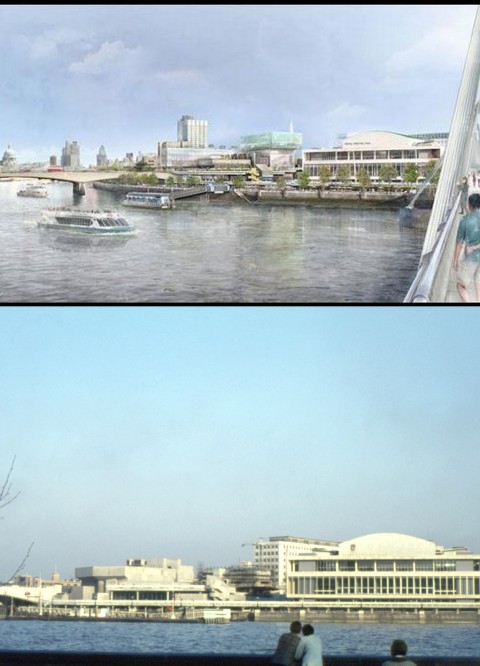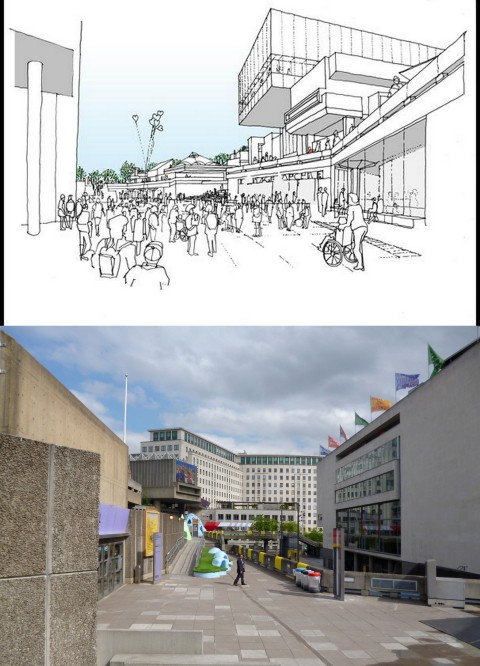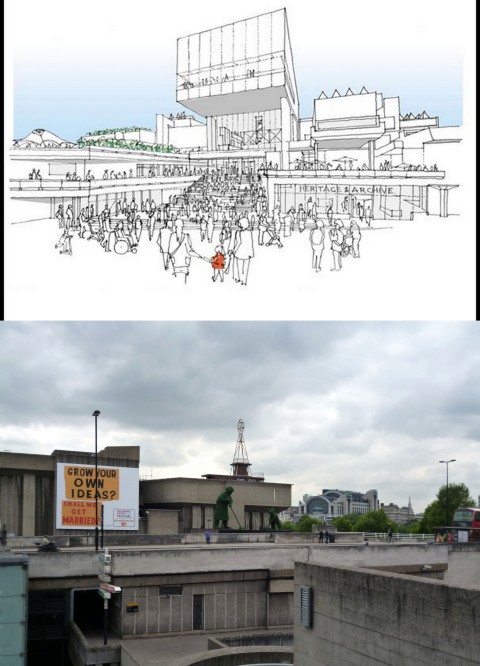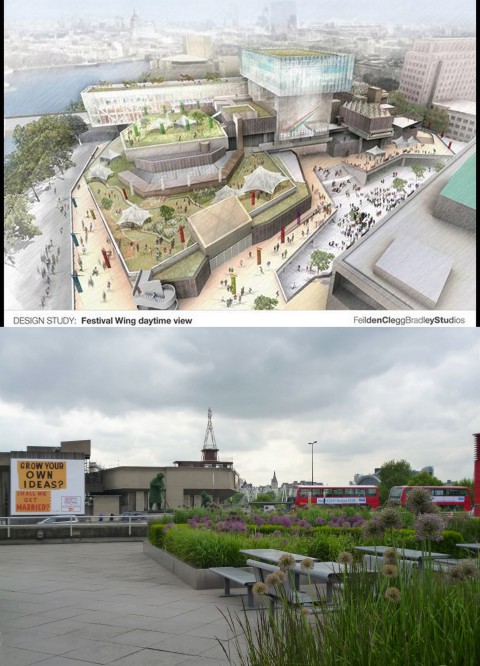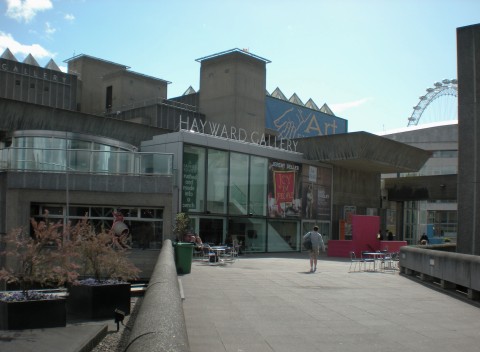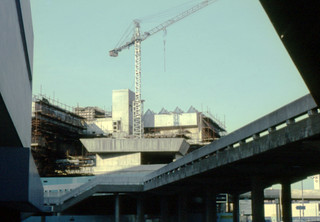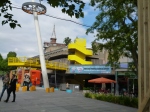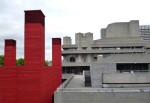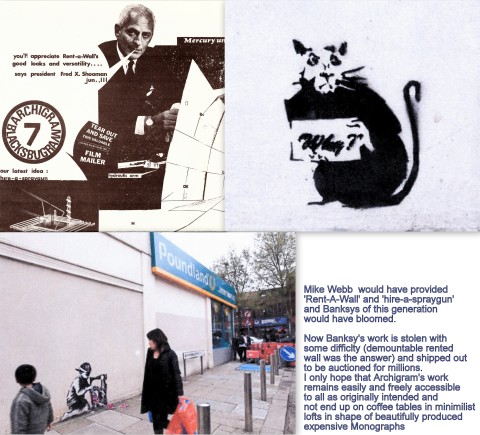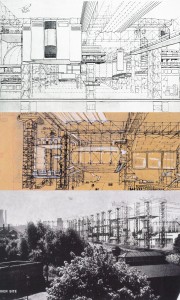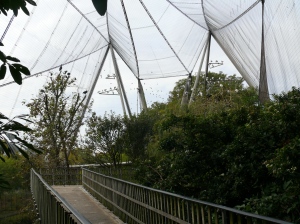Latest South Bank Redevelopment Plans, London
June 18, 2013
South Bank Redevelopment Proposals by Fielden Clegg Bradley Studios.
( 4th July 2013. After some serious criticisms from National Theatre, the client/architects has agreed to withdraw the current planning application to carry out further work before resubmitting it. Sensible move for all concerned and us.)
You may have gathered from my recent contributions on Flickr that I have virtually grown with the South Bank and have been a frequent user of all the venues in this area from early 60s to now.
I have also admired Fielden Clegg Bradley Studios work for some time. With this background, I would like to express some of my initial views concerning the proposals which are based on fairly sketchy information released to the press.
I was of the view that this complex should not be listed, however appointment of an intelligent architectural practice and a sensible brief was essential to do justice to the site and it was a relief to see FCB appointed.
It is obvious that the client is desperate to cram maximum accommodation on this site to meet their expectations after leading a frustrated existence without having many ‘bells and whistles’ similar recently built projects have in major cities.
Architects seem to be performing a difficult ‘tight-rope’ trick and their initial offerings seem quite an outstanding achievement. This is not a bad time to raise concerns by observers who know this area and its history of growth and have some constructive criticism to offer.
The architectural pedigrees of the original 60s buildings and RFH are well known and ‘over-reverential’ architectural approach to alterations sometime expected by conservationists would be inappropriate in this instance.
The proposals for central raised block facing RFH may appear large but I see this as a good location to gain badly needed accommodation.
My only observation (not a criticism) is that the existing pedestrian route under Waterloo Bridge connecting this main space to the terraces of National Theatre is extremely restricted and arrival at the side of NT from under the bridge is a disappointing experience and is a bit of an anti climax. Some improvements around here, with blessings of NT, would be hugely beneficial to all concerned.
My main concerns relate to the long glass block running parallel to the bridge housing Poetry Library, Literature Centre and Restaurants.
The building works and fits well when seen from Hungerford Bridge side as it acts as another ‘book-end’ (the other one being the new building between RFH and railway track) and neatly contains the activities on this side of the Waterloo Bridge.
However, in my opinion all the negative factors come into play from Waterloo Bridge and NT side. Let me share some of these negative aspects and its impact on the surrounding area.
- The pedestrians and drivers when crossing the bridge are able to see concrete structures of NT on one and QEH, Hayward on the other side with their distinct ‘idiosyncratic approaches’ almost having a dialogue with each other.
This would be interrupted by the new block at least at QEH end.
- The end elevation of this block as seen by people on the bridge approaching Waterloo Station would be out of character and far from satisfactory in its scale and appearance. Although the views from inside this building can be very exciting.
- The views from the roof terraces of National Theatre currently enjoying the side elevations of QEH would be lost for ever depriving the witty bouncing of a concrete banter between these dissimilar but contemporary icons.
- Walking at the bottom of a fairly long sheer wall of this block close to the Bridge pavement is alien in to the local urban context. A similar situation is only experienced where the pavement abuts the building line in Lancaster Place which directly relates to context of Strand and well before the bridge starts. Once you are on the bridge the ability to look down from pavements on both sides exists throughout the length of the bridge which will be disrupted by this block.
An important architectural location without listed status puts even more onerous responsibility on a caring and gifted architect and the client. This is a good scheme to prove that excellent results are possible to obtain without ‘crutches’ of listing status.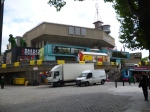
The end of the linear block would rise on the left of QEH. Lower floor is probably Cafe or Restaurant.
The views from the footpaths of Waterloo Bridge give you glimpses of a busy riverside walk and various terraces of NT.
All sketches and perspectives from Architects press release and photos by Iqbal Aalam.
More photographs of this and other GLC projects see
Archigram to Banksy
February 24, 2013
I bought Archigram magazine as a student in 60s and being an ardent follower, attended as many of their events as I could at that time. Architectural Design used to cover their work regularly and had a big readership among students.
I have been putting occasional scanned images from my Archigrams on Flickr site since 2008 (before the Archival Project existed) and recently a Blog for Archigram Monte Carlo 1969 competition entry published in AD of January 1970. Both my Flickr site and Blog have no commercial slant and simply aim to bring Archigram (and other architectural work of note) as a study resource easily available to the new generations of architectural students and teachers every where in the world, who may know little about the scope of their work and tremendous impact this group made on second half of 20th century.
Having a quick look at the ‘views’ recorded for my Flickr and Blog site for Archigram’s work, I can confidently say that figure is around 50,000. The hits come in clusters and it is not difficult to guess the part of the globe (Papua New Guinea to Peru) where some architectural student class is currently studying some aspect of Archigram’s work by looking at the viewing records against the global time differences
I do ‘smell a rat’ when all of a sudden I am approached by a ‘publisher’ talking about ‘infringements of copyrights’ as I see some kind of profit motive lurking in the background. I know enough about these issues including character and purpose of my web sites at the same time I would hate to do anything to upset either the ‘Archigram Archives’, any original architects or their heirs who are the owners of the copyright. If any of these find any use of the images on my sites offensive, damaging or unacceptable in any way, please write to me as I would withdraw any offensive image or make suitable amendments.
‘Slave Labour’photo by Nigel Howard for London Evening Standard.
Arcives are here: http://archigram.westminster.ac.uk/
As promised at the end of February 2013, I welcome the spring by removing all the images from this Blog I uploaded at the end of July 2012. This saddens me but is to conform with the note received from Archigram Archives representative on 22 February 2013 (see below) about the use of copyright materials, a fact which is undeniable. However, my intentions were simply aimed at offering an open learning resource, sharing original Archigram intentions, when I as a student, bought the original magazines for pennies. In todays world these would have been available as a free/open resource for downloading on Internet.
I intend to revisit this Blog in future after studying the background of the competition and looking at some of the social/political changes which were taking place at that time eventually leading to the cancellation of this as a viable project.
This was a limited competition for an entertainment and sports building on the reclaimed foreshore of Monte Carlo. Archigram reached the final stage and came very close to building in this glamorous city to provide the vibrancy displyed in their graphics.
The Brief required a multi- purpose space to cater for large banquet; variety shows, a circus, Ice rink and cultural activities were also eagerly sought. Architects noticed the lack of a public park and this beach side proposal could extend its services but remained complimentary in atmosphere and experience.
David Greene’s Rockplug/Logplug acted as an inspiration, grassy bank with trees placed over the hole in the ground livened up this depressing area, while offering a glamourous setting as illustrated by liberal use of scanty clad women armed with sun glasses, and a grid of plug-in points for headphones and other modern paraphernalia livening up the site to fit in the famous city of Monte Carlo. All the major functions brief required were housed in a large circular space chosen for its structural properties, covered with a shallow dome hidden under grass, offering extensive supports for all the technoligical kits Archigram could provide to improve upon Cedric Price’s Fun Place and Piano Rogers Beaubourg project.
The aim was to provide a large enough space for banquets, elephants or go-karts; adapting from chamber music to ice hockey. A place where the envelope and architecture was to become subservient to events and the structural systems and services providing magic tricks for multi-use were only playing the ‘second fiddle’.
The buried space was served by six entrances, each show making its own environment, organization and circulation patterns.
Most of the facilities like toilets, normally built-in were designed to be mobile, using a comprehensive set of kit of parts, set at a 6m metre grid and gantries. The aim was to design a place not dissimilar to a live television studio, not unlike ‘Instant City’ in one location. No dividing line between performance and transmitted event (projection, overlay of media). Even after frequent visit to these activities, the visitors may not be able to appreciate the size or configurations within this large cavern.
An architecture that was to be made of the events rather than the envelope as it is likely Archigram considered Beaubourg was.
Peter Cook, Dennis Compton, Colin Fournier, David Greene with Ken Allison, Diana Jowsey, Stuart Lever. Engineered by Frank Whitby.
PS: I am informed that Ron Herron worked on the competition albeit whilst he was in America and consequently on the unbuilt scheme.
The information and original scans are attributed to an article in Architectural Design 1/70 Cosmorama
Cedric Price, Influential architect and theoritician.
December 5, 2011
Archigram is well known and its influences on architectural world are clearly understood and illustrated. The name of Cedric Price (1934-2003) is often heard in Archigram circles as he was close to the group and took active part in discussions and even contributed but was never a formal member.
He was born in Potteries his father was an architect who specialised in Art Deco Cinema design. Cedric Price was trained at Cambridge and AA where he also taught influencing many architects, Richard Rogers, Rem Koolhaas, Will Alsop to name a few. He also worked for Maxwell Fry & Denys Lasdun before setting his own practice to build Aviary for London Zoo. He built very little but like many other thinkers had tremendous influence on future direction of architecture which continues to this day.
He was a believer in “calculated uncertainty” where adaptable, temporary structures were preferred. He believed that an ‘anticipatory architect’ should give people the freedom to control to shape their own environments. All buildings according to him should allow for obsolescence and complete change of use. Will Alsop, who worked for him in early 70s recalls CP’s delight in designing a Cafe for Blackpool Zoo which was eventually to be turned into a giraffe home. This fitted perfectly into his themes of uncertainty, adaptability and change.
In his ‘Thinkbelt’ University project he proposed simple, moveable buildings which would deliver education “with the same lack of peculiarity as the supply of drinking water.”
His most influential project was ‘Fun Palace (1961) ‘ for Joan Littlewood. It was killed off by local government bureaucracy. The design of Richard Rogers and Renzo Piano’s Pompidou Centre in Paris is called a direct descendant. Soon after that he designed ‘ Potteries Thinkbelt (1964)’ which still makes great deal of sense. Among his built projects only Aviary in London Zoo remains, as he ensured that the other temporary structure for a community use ‘Inter-Action Centre’ in Kentish Town was not listed but demolished as intended. It is also amusing to recall that he was the only architect who was a fully paid-up member of ‘Britain’s National Institute of Demolition Contractors’.
“Aviary was designed for a community of birds and his idea was that once the community was
established it would be possible to remove the netting . The skin was a temporary feature: it only needed to be there long enough for the birds to begin to feel at home and after that they would not leave anyway. ………Price the theoritician, functionalist was frightened of and avoided style. …. he wasn’t interested in being remebered. He was building a memory.” 1*
Later in his life he worked on ‘Magnet City’ which was an exercise in using intermediary spaces in London urban landscape to stimulate new patterns and situations for urban movement in the city. shown in an exhibition in 1997.
He also contributed to the ‘Non-Plan’ debate with Paul Baker and Peter Hall. This basically was an ‘anti-planning polemic’ which resulted in the formation of ‘enterprise zones’ like Canary Wharf in London and ‘Metroland’ in Gateshead. On personal level I never came to see great sense in this reaction against the previous planning failures and put in their this ‘free for all’ American style money making system even if it generated big business and attracted lots of users.
1* Will Alsop’s recollections.
Photo above shows three views (interior & exterior) of Fun Palace by Cedric Price 1962.
